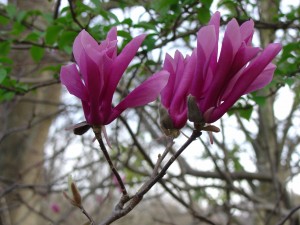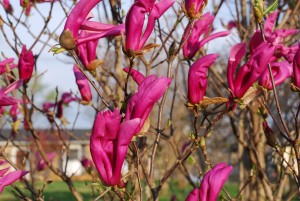Star (Magnolia stellata) and tulip (M. soulangeana) magnolias are early flowering magnolias. Early spring frosts destroy open flowers. In the mid-1980’s the U.S. National Arboretum released 8 shrub-type cultivars as a series called the “Little Girl Magnolias”. They are hybrid crosses between M. liliiflora and M. stellata. Four cultivars- ‘Ann’, ‘Betty’, ‘Susan’, and ‘Jane’ – became the popular choices in the series (USDA hardiness zones 4-8).
These hybrid magnolias turned out to be great leaps forward in developing a late flowering magnolias that avoided frost injury. Each Little Girl cultivar blooms in early spring (some places in late spring). Large goblet-shaped flowers are comprised of 6 to 9 inches long strap-like tepals (petals and sepals) and are real eye-catchers.
Flower colors vary by cultivar, in pink to purple shades: Ann (pinkish-red), Betty (reddish-purple), Jane (dark purple), Susan (purplish red). They often surprise with occasional blooms in the summer and early fall. Plants are commonly multi-stemmed large shrubs, but can be trained as small trees. Over ten years these deciduous shrubs will measure 10- 15 feet height and spread.
Little Girl magnolias grow in moist, well-drained soil, preferably an acidic pH, and in full to partial sun (4 – 5 hours minimum sunlight). Roots will not tolerate soppy wet ground. Prune spring flowering magnolias soon after the spring flowering flush is over. Prune to remove basal suckers and to maintain the desired form of the shrub or tree magnolia.
The deciduous leaves are thick and leathery and cope summer heat and drought. With proper care and in the right planting site, these hybrid magnolias are generally long-lived and disease and pest problems are rare.



 Posted in
Posted in 
